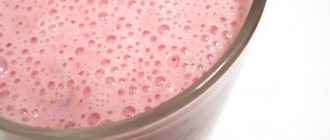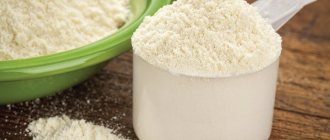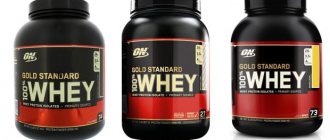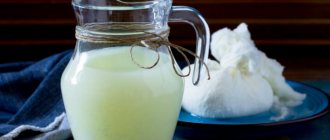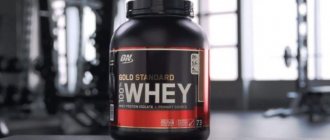The benefits of drinking protein shakes when gaining muscle mass. Their main varieties and nuances of choice. The Internet is a source of knowledge, no doubt. But it contains a lot of contradictory information that cannot be trusted unquestioningly - it must be “filtered”. In particular, novice athletes are faced with statements that drinking protein is very harmful. At the same time, additional protein is completely dangerous for teenagers. So, is protein bad for your health? Let's look at this in more detail.
About protein
When it comes to protein and its “harm” to the body, you want to “scream” about the stupidity of this statement. Protein contains many different amino acids that are necessary for building a healthy body. We are made of meat, for which amino acids are the “building blocks”, the basis for growth.
A child's body is special. Many people know that proteins tend to break down, because they are difficult to classify as stable compounds. Moreover, in children and adolescents, the process of destruction occurs much more slowly than the process of creating protein cells. Due to this, the body grows and develops. In adults, the opposite is true - protein destruction occurs faster than its creation. As a result, we grow old and die.
What does it mean? Protein is the basic element for life. It must be obtained from food, and in case of deficiency, from sports nutrition. There is nothing reprehensible in this. At the same time, adults need much more protein than teenagers, whose breakdown process is not yet so active.
Nutrition for children and adolescents involved in sports.
The problem of nutrition has been and remains very important for athletes and their coaches. When compiling a diet, first of all, attention is paid to ensuring energy balance: the intake of calories into the body must be strictly balanced with their expenditure.
The child’s body, even at rest, consumes energy. With muscular and mental work, metabolism increases. Compared to lying down, energy consumption increases even when sitting quietly by 12%, when standing - by 20%, when walking - by 80 - 100%, when running - by 400%.
Energy expenditure varies depending on the age of the children. Energy can only be replenished through nutrition. For food to be of maximum benefit, it must contain all the substances that make up our body: proteins, fats, carbohydrates, minerals, vitamins and water. The daily requirement for basic nutrients and energy for children and adolescents of various age groups is given in table. 13.
Food is an external factor that turns into an internal factor through transformation into energy and into the structural elements of our body. With a pronounced shift in metabolism, the body’s need for inorganic and organic substances from the environment, the totality of which is called food, also changes. The process of entering the body and assimilating food is defined as nutrition.
Food that supplies us with material to cover energy and plastic costs must be balanced within certain limits, that is, meet the body’s needs for irreplaceable environmental factors.
The most complex and important principle of nutrition is the balance of the diet (diet, menu) according to the essential food factors: proteins, fats, carbohydrates, mineral elements, vitamins and water.
In order to ensure high digestibility, nutritional value, utilization and efficiency of the protein part of the diet, it is necessary to have at least 50% protein of animal origin, the rest - vegetable. For athletes, this is the minimum value; it can and should be increased to 70-80%.
The most optimal ratio of amino acids, primarily essential ones, is achieved by consuming protein products of animal and plant origin: meat, fish, milk and their products, poultry, eggs, bread, cereals. The optimal ratio between animal and vegetable fats is taken to be 7:3. If you use fresh vegetable oil that has not been subjected to heat treatment, then this ratio guarantees the intake of many biologically valuable fats into the body: polyunsaturated fatty acids, phosphatides, etc.
It should be recalled that our usual cooking techniques require a large amount of fat, much more than is necessary. Unfortunately, these fats after heat treatment (frying, prolonged boiling) become less valuable for the body.
As for carbohydrates, there are also certain requirements and relationships for them. As part of food products, they can be divided into two groups: complex and simple. For us, complex ones are starch in bread, cereals, potatoes, etc., and simple ones are sweet-tasting carbohydrates: granulated sugar, refined sugar, glucose on their own or as part of food products. The optimal ratio between them should be 3:2. If the diet includes a wide range of foods containing protein, bread, cereals, a variety of fresh vegetables and fruits, then you can be sure that the diet is properly balanced in both minerals and vitamins.
Particular attention should be paid to vegetables, herbs, fruits and berries. In order to meet the standard requirements for most vitamins and minerals for a healthy young person (daily energy expenditure 2800-3000 kcal), you need throughout the year: potatoes - 110 kg, vegetables - 117 kg, melons (watermelons, melons, pumpkins) - 24 kg and fruits - 82 kg. It is recommended that of the total vegetable consumption, cabbage should be 25%, tomatoes – 15%, carrots – 16%, cucumbers – 10%, beets and onions – 6% each. The remaining 28% should be whole vegetables such as eggplant, zucchini, spinach, sorrel, lettuce, radishes, turnips, rutabaga, etc. Of fruits, apples should account for about 35%, grapes - 8%, citrus fruits - 10% , cherries, plums, pears, raspberries, strawberries, currants - 4-5% each, the rest - gooseberries, apricots, peaches, wild berries, etc.
For a teenage athlete who spends, for example, 4000-4500 kcal per day, 1.3-1.5 times more of these valuable products is needed. These are the norms and ideas about proper nutrition. However, in practice, typical errors occur and are widespread.
The first, most “popular” one is excess caloric content of food. The main principle of a balanced diet is violated - the balance between energy expenditure and energy consumption. We consume more animal fats and carbohydrates than necessary in the form of sugary foods, baked goods and confectionery. Constant excess consumption very soon leads to fat deposition.
The second serious drawback is the lack of vegetables and fruits, edible roots, and herbs in the diet. It would be much more useful to visit with fruits, treat friends to vegetable salads with vegetable oils, and organize competitions for the best dish of vegetables and fruits. It may be unconventional, but it is quite modern. A lack of plant products leads to a deficiency in the body of vitamins, potassium salts, magnesium, iron, trace elements and many biologically active substances.
It is in search of the latter that we turn to medicinal products, which often represent a concentrated extracted fraction from plants that were once consumed as food, but today are inaccessible, beneficial for our body. With a deficiency of plant foods in the diet, obesity and associated diseases (atherosclerosis, coronary heart disease and hypertension), various anemias, colds and viral diseases are more easily developed.
In addition to shortcomings in the quality of food, there are also errors in the nutrition process itself. This is insufficient frequency and irregularity of meals. Low frequency of meals (two to three times), even with sufficient energy value of the diet, adversely affects the metabolism of proteins, fats, and carbohydrates. And the optimal frequency of nutrition (4-5 times) allows us to create favorable conditions for our body for all metabolic processes and makes it easier to adapt to any type of stress.
Irregularity implies non-observance of consistency in meal times and the absence of a probable need to combine motor activity and food “activity”. What are we talking about here? Many internal processes of our body, including metabolism, are subject to certain daily rhythms and fluctuations, manifested in a decrease or increase in the activity of certain enzymes, including digestive enzymes, in changes in the content of energy (glucose, fats) and plastic (amino acids) of the material, in the action of biologically active substances (hormones, for example). The “driver” of such rhythms is, first of all, the change of day and night, active physical activity, and nervous and emotional stress.
A few words about the drinking regime. The need of a child's body for water is higher than that of an adult, since cell growth is possible only in the presence of water. An adult needs 40 ml of fluid per day per 1 kg of body weight, and a child 6–7 years old needs 60 ml (1–2 liters per day). Sometimes during meals children ask for water. Drinking water before eating has different effects depending on whether the child is thirsty or not. When thirsty, drinking water is accompanied by an increase in the secretion of the salivary glands, which has a positive effect on the child’s appetite. In cases where the child does not feel thirsty, drinking water can inhibit secretion, which is accompanied by a decrease in appetite. Both a lack and an excess of fluid have equally harmful effects on the body. With excess water, the load on the cardiovascular and excretory systems – kidneys and skin – increases. Vitamins and minerals are excreted from the body simultaneously with urine and sweat.
It is especially important to follow a general training and nutrition regimen when playing sports. First of all, this is dictated by the nature of the training process, which must be programmable, predictable and controllable and which cannot be ensured in the absence of a time regime, regularity and regulations. Probably every coach knows how to conveniently conduct training in the conditions of a training camp, and every coach is familiar with the problems of an uncontrollable athlete at home, when it is difficult to be sure of his compliance with the regime and diet. It is appropriate to recall here that nutrition is a powerful means of restoring physiological, biochemical and other indicators of performance and its impact must be regulated.
Sports nutrition itself has its own specific tasks, arising from the goals that the athlete solves at each individual stage of training and competition (micro-, meso-, and macrocycles). This includes such settings as developing strength, increasing muscle mass, speed-strength qualities of muscles, general and special endurance. The need to use sports nutrition requires discussing the issue with a sports doctor and trainer.
Only eliminating the listed typical nutritional errors will allow you to successfully engage in sports.
The need for nutrients and energy of students in general education institutions aged 7 to 11 and over 11 years (SanPiN 2.4.5.2409-08)
| Name of nutrients | Average nutritional requirements for students of two age groups | |
| From 7 to 11 years | Over 11 years old | |
| Proteins (g) | 77 | 90 |
| Fat (g) | 79 | 92 |
| Carbohydrates (g) | 335 | 383 |
| Energy value (kcal) | 2350 | 2713 |
| Vitamin B1 (mg) | 1,2 | 1,4 |
| Vitamin B2 (mg) | 1,4 | 1,6 |
| Vitamin C (mg) | 60 | 70 |
| Vitamin A (mg ret.eq) | 0,7 | 0,9 |
| Vitamin E (mg current equivalent) | 10 | 12 |
| Calcium (mg) | 1100 | 1200 |
| Phosphorus (mg) | 1650 | 1800 |
| Magnesium (mg) | 250 | 300 |
| Iron (mg) | 12 | 17 |
| Zinc (mg) | 10 | 14 |
| Iodine (mg) | 0,1 | 0,12 |
The need for nutrients and energy of students in educational institutions of primary and secondary vocational education (SanPiN 2.4.5.2409 – 08)
| Name of nutrients | Nutrient requirements for male and female students | |
| Boys 15 -18 years old | Girls 15 – 18 years old | |
| Proteins (g) | 98 — 113 | 90 — 104 |
| Incl. animal origin | 59 -68 | 54 – 62 |
| Fat (g) | 100 — 115 | 90 — 104 |
| Incl. plant origin | 30 — 35 | 27 – 31 |
| Carbohydrates (g) | 425 — 489 | 360 — 414 |
| Energy value (kcal) | 3000 — 3450 | 2600 — 2990 |
| Vitamins: | ||
| Vitamin C (mg) | 70 | 70 |
| Vitamin A (mg ret. equiv)* | 1,0 | 0,8 |
| Vitamin E (mg current eq)** | 15 | 12 |
| Thiamine (mg) | 1,5 | 1,3 |
| Riboflavin (mg) | 1,8 | 1,5 |
| Pyridoxine (mg) | 2,0 | 1,6 |
| PP (mg Niac.eq)*** | 20 | 17 |
| Folate (mcg) | 200 | 200 |
| Minerals: | ||
| Calcium (mg) | 1200 | 1200 |
| Phosphorus (mg) | 1800 | 1800 |
| Magnesium (mg) | 300 | 300 |
| Iron (mg) | 15 | 18 |
| Iodine (mg) | 0,13 | 0,1 |
Misconceptions
Many people believe that protein is a chemical product and therefore harmful. This approach is erroneous and baseless. In fact, protein sports nutrition is made exclusively from natural products - there are no “chemicals” in it. But we have plenty of it in mayonnaise, sauces, canned food and other products on our table. Therefore, the question of whether you should drink protein disappears by itself. If you need it to achieve high athletic results or due to an acute shortage in the body, then why not.
conclusions
Most children do not need protein supplements. Too much protein can be harmful, and there is no evidence that protein powder helps children grow. Anyone concerned about a child's nutrition, height or weight should talk to a doctor.
If a child is not getting enough protein from food, the doctor recommends an age-appropriate supplement with few ingredients and no added sugar.
Research article on the topic: Healthy eating improves reading skills in children.
Research
Many studies have been conducted on the harm of protein and its effect on the body of adolescents. No negative effects were found. There is only one danger, but it has a psychological basis. A teenager who started with “weak” supplements may eventually switch to more dangerous ones, for example, steroids.
The problem is that the child is too susceptible to what is shown on TV. He wants to be the most beautiful, to arouse the envy of his peers, and girls like him. For this reason, he may take dangerous drugs without even thinking about their negative effects.
Protein alternative - healthy eating
Feeding your baby nutritious, whole foods can be a less expensive and healthier alternative to relying on chemical supplements to meet your baby's protein needs.
The Center for Young Women's Health at Boston Children's Hospital recommends including the following foods to ensure you're getting enough protein:
- Peanut butter, tortilla cheese.
- Tortilla roll with fried eggs, cheese and salsa.
- Hummus with carrots, turkey burgers and tofu, or fried chicken.
If you are choosing cocktails for your children, carefully check the manufacturers. Some cocktails may contain heavy metals, which are especially dangerous for children.
What about as a teenager?
There is an opinion that it is better for teenagers not to drink protein. This is partly true, but not because it is harmful or dangerous. It’s just that at a young age you can get excellent results without sports supplements - just organize the right diet with all the necessary beneficial elements and vitamins. Combined with quality training, this gives results. If you need to take additional protein, please do so. There's nothing wrong with that. The main thing is to follow the dosage and take into account contraindications, which we will discuss below.
On the other hand, teenagers are not recommended to take supplements that have a strong effect on the hormonal system - they are really dangerous. It makes no sense to increase testosterone levels, because they are already very high. Additional substances can only harm a young body.
How much protein does a child need per day?
The amount of protein a child or teenager needs per day depends on age, activity level and gender.
Today there are the following recommendations:
| Age | Protein requirement per day |
| 1–3 years | 13 grams (g) |
| 4–8 years | 19 g |
| 9–13 years | 34 g |
| 14–18 years old (girls) | 46 g |
| 14–18 years old (boys) | 52 g |
The American Academy of Pediatrics adds that active children may need a little more protein.
What can you take?
Until the age of 16, protein will not be superfluous for teenagers who set serious goals for themselves and plan to achieve success in bodybuilding. The full amount of nutrients can be obtained from food, but this is not always possible due to the increased needs of the athlete’s body. For example, a young body needs about 1.5-2 grams per kilogram of weight. It’s easier to eat one or two protein bars and drink a protein shake than to swallow a dozen eggs or a kilogram of meat and cottage cheese.
Don't forget that there are different forms of proteins. For teenagers under 16 years of age, the best options are whey and casein proteins. They are absorbed differently and provide the body with the full amount of protein within 24 hours. Vegetarians can take soy protein (but again, without fanaticism).
By the way, it is necessary to remember that low-calorie protein products (shakes, bars) are useful for teenagers who want to maintain weight and strength without gaining a lot of mass. If you need to gain weight, then it is better to drink high-calorie mixtures.
From the age of 16 onwards, you can take not only the above-mentioned supplements, but also a number of others - creatine, glutamine, anabolic flavones, amino acids, and so on.
Are Protein Powders Beneficial for Children?
There is currently no evidence that protein powders are beneficial for children. In a 2015 review, researchers analyzed existing data on the effects of protein supplements in children with chronic diseases such as cystic fibrosis and cancer. This category of children often lacks appetite or is unable to absorb nutrients.
The researchers found that taking protein powder did not lead to significant improvements in weight and height. However, it is important to note that these findings may not apply to healthy children. It's best to get your protein from whole foods such as fish, eggs and plant sources such as legumes. If your child cannot get enough protein this way, discuss protein supplements with a nutritionist or pediatrician.
Protein powders typically contain protein from plant or dairy sources. Examples include:
- whey protein, which comes from milk
- pea protein
- brown rice protein
It's important to note that protein powders may contain a number of additional ingredients. Powders can be nutritious, such as vitamins and minerals, or less beneficial, such as sugar. If the doctor agrees that a protein powder is needed, take one that contains the appropriate amount of protein based on the child's age and how much he currently consumes.
In addition, you need to choose a powder that:
- contains no added sugars
- does not contain high doses of vitamins, minerals or other nutrients
- contains as few ingredients as possible


